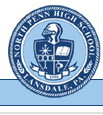EPICS
@ Purdue |
|
2016-2017 NPHS
Community: Advanced Clock Development
Team Members |
|
North Penn High school opened in 1971.
Many of the clocks and their corresponding
control system often experience technical
issues, such as, displaying the incorrect
time or not working at all. They are
original to the building and are over 40
years old.
North Penn High School also has a multitude
of different bell schedules: (1) Regular 8
period bell, (2) 9 period bell, (3) Knight
Time, and (4) Two hour delayed opening bell
schedule. Also, there are modified
schedules for testing and school wide
assemblies. The challenge for students
and teachers in the building is to determine
what letter day it is, what time the period
ends, how many minutes are left in the class
and more.
Problem Statement 1:
Many clocks within North Penn High School
are difficult to read and inconsistently
display times. Furthermore, there are three
different time schedules depending upon the
day. The clocks can be innovated to show
broader, more relevant information. |
Determining the need / Justifying the
research - School Wide Survey:
Part 1: Define the Problem:
|
|
North Penn High School also has a multitude of
different bell schedules: (1) Regular 8 period bell,
(2) 9 period bell, (3) Knight Time, and (4) Two hour
delayed opening bell schedule. Also, there are
modified schedules for testing and school wide
assemblies. The challenge for students and
teachers in the building is to determine what letter
day it is, what time the period ends, how many
minutes are left in the class and more. |
Part 2: Justifying the need - survey development and results
|
|
School
Wide Survey:
The team developed and disseminated a school
wide survey via the North Penn High School morning
show. The survey, developed using Google
forms, was designed to determine if there is an
actual problem with the clocks in the building and
if there is a need for a solution.
Survey
results: Coming soon! |
Part 3: Current State of the Art
Part 4: Brainstorming
Part 5: Selection of a potential solution
Part 6: Design, bread boarding, and prototyping
Part 7: Solution testing
Part 8: Final Product |
